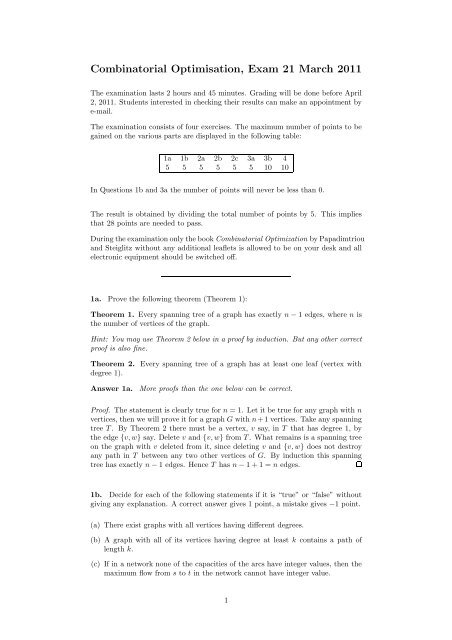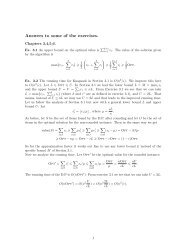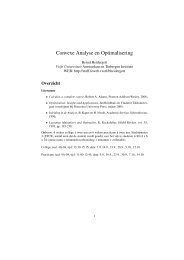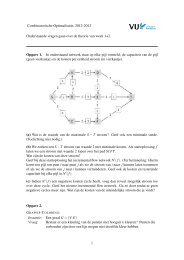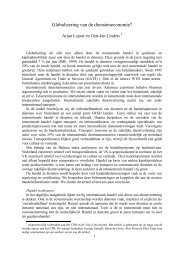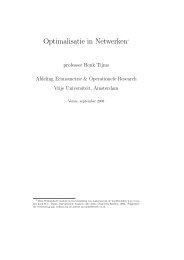You also want an ePaper? Increase the reach of your titles
YUMPU automatically turns print PDFs into web optimized ePapers that Google loves.
Combinatorial Optimisation, Exam 21 March 2011<br />
The examination lasts 2 hours and 45 minutes. Grading will be done before April<br />
2, 2011. Students interested in checking <strong>the</strong>ir results can make an appointment by<br />
e-mail.<br />
The examination consists of four exercises. The maximum number of points to be<br />
gained on <strong>the</strong> various parts are displayed in <strong>the</strong> following table:<br />
1a 1b 2a 2b 2c 3a 3b 4<br />
5 5 5 5 5 5 10 10<br />
In Questions 1b and 3a <strong>the</strong> number of points will never be less than 0.<br />
The result is obtained by dividing <strong>the</strong> total number of points by 5. This implies<br />
that 28 points are needed to pass.<br />
During<strong>the</strong>examinationonly<strong>the</strong>bookCombinatorial Optimization byPapadimtriou<br />
and Steiglitz without any additional leaflets is allowed to be on your desk and all<br />
electronic equipment should be switched off.<br />
1a. Prove <strong>the</strong> following <strong>the</strong>orem (Theorem 1):<br />
Theorem 1. Every spanning tree of a graph has exactly n−1 edges, where n is<br />
<strong>the</strong> number of vertices of <strong>the</strong> graph.<br />
Hint: You may use Theorem 2 below in a proof by induction. But any o<strong>the</strong>r <strong>correct</strong><br />
proof is also fine.<br />
Theorem 2. Every spanning tree of a graph has at least one leaf (vertex with<br />
degree 1).<br />
Answer 1a. More proofs than <strong>the</strong> one below can be <strong>correct</strong>.<br />
Proof. The statement is clearly true for n = 1. Let it be true for any graph with n<br />
vertices, <strong>the</strong>n we will prove it for a graph G with n+1 vertices. Take any spanning<br />
tree T. By Theorem 2 <strong>the</strong>re must be a vertex, v say, in T that has degree 1, by<br />
<strong>the</strong> edge {v,w} say. Delete v and {v,w} from T. What remains is a spanning tree<br />
on <strong>the</strong> graph with v deleted from it, since deleting v and {v,w} does not destroy<br />
any path in T between any two o<strong>the</strong>r vertices of G. By induction this spanning<br />
tree has exactly n−1 edges. Hence T has n−1+1 = n edges.<br />
1b. Decide for each of <strong>the</strong> following statements if it is “true” or “false” without<br />
giving any explanation. A <strong>correct</strong> answer gives 1 point, a mistake gives −1 point.<br />
(a) There exist graphs with all vertices having different degrees.<br />
(b) A graph with all of its vertices having degree at least k contains a path of<br />
length k.<br />
(c) If in a network none of <strong>the</strong> capacities of <strong>the</strong> arcs have integer values, <strong>the</strong>n <strong>the</strong><br />
maximum flow from s to t in <strong>the</strong> network cannot have integer value.<br />
1
v1 v2 v3 v4 v5<br />
u1 u2 u3 u4 u5 u6<br />
Figure 1: Graph instance of Question 2b. Matching edges are indicated in bold.<br />
(d) If in a networknone of<strong>the</strong> capacities of<strong>the</strong> arcshaveinteger values, <strong>the</strong>n it can<br />
happen that <strong>the</strong> value of a maximum flow is not equal to that of a minimum<br />
cut.<br />
(e) Given a weighted undirected graph, no two edges of which have equal weight.<br />
Any such a graph has a unique minimum spanning tree.<br />
Answer 1b.<br />
(a) False<br />
(b) True<br />
(c) False<br />
(d) False<br />
(e) True<br />
2a. Consider any graph G = (V,E). Make a subdivision of each of <strong>the</strong> edges:<br />
i.e., for every edge e = {u,v} ∈ E create an extra vertex ve and replace <strong>the</strong> edge<br />
{u,v} by <strong>the</strong> two edges {u,ve} and {ve,v}. (You may think of it as every edge of G<br />
getting an extra vertex in <strong>the</strong> middle.) Prove that <strong>the</strong> resulting graph is bipartite.<br />
Answer 2a. More proofs can be <strong>correct</strong> than <strong>the</strong> one below.<br />
Proof. Take any cycle of <strong>the</strong> new graph (call this graph G ′ ). This is of <strong>the</strong> form<br />
{v1,v {v1,v2},v2,...,vk,v {v1,v2},v1} hence of even length. Since a bipartite graph is<br />
a graph without odd cycles G ′ must be bipartite.<br />
2b. Given is an unweighted bipartite graph G = (V,E) displayed in Figure 1.<br />
And given is a matching displayed as boldface edges in Figure 1. Starting from this<br />
matching determine a maximum matching by using <strong>the</strong> augmenting path method<br />
or conclude that <strong>the</strong> current matching is optimal.<br />
2c. Theorem 3. Inabipartitegraph,<strong>the</strong>sizeofamaximumcardinalitymatching<br />
is equal to <strong>the</strong> size of a minimum cardinality vertex cover.<br />
Prove this <strong>the</strong>orem.<br />
Answer 2c. More proofs can be <strong>correct</strong> than <strong>the</strong> one below.<br />
2<br />
v6
Proof. Let µ ∗ be <strong>the</strong> size of a maximum cardinality matching and τ ∗ <strong>the</strong> size of a<br />
minimum vertex cover. Given any matching at least one vertex of each of its edges<br />
must be in <strong>the</strong> vertex cover. Hence τ ∗ ≥ µ ∗ .<br />
To prove that τ ∗ ≤ µ ∗ , take <strong>the</strong> maximum perfect matching M. Start <strong>the</strong> search<br />
tree for augmenting paths from all exposed vertices of V, w.r.t. M. Clearly, this<br />
does not reach any exposed vertex of U w.r.t. M. Select all <strong>the</strong> U-vertices in this<br />
search tree, which are all incident to edges of M. Similarly, select all <strong>the</strong> V-vertices<br />
in <strong>the</strong> search tree from all exposed vertices of U w.r.t. M. In this way we have<br />
selected |M| = µ ∗ vertices. We claim that <strong>the</strong> selected vertices form a vertex cover.<br />
Suppose not, <strong>the</strong>n <strong>the</strong>re exists an edge {u,v} such that nei<strong>the</strong>r u nor v is in <strong>the</strong><br />
cover. None of <strong>the</strong> two can be an exposed node, o<strong>the</strong>rwise <strong>the</strong> o<strong>the</strong>r one would be<br />
in <strong>the</strong> cover. But <strong>the</strong>n ei<strong>the</strong>r u is reachable by an alternating path from an exposed<br />
node of V or v is reachable from an exposed node of U, hence one of <strong>the</strong> two must<br />
be in <strong>the</strong> cover.<br />
3a. Decide for each of <strong>the</strong> following statements if it is “true” or “false” without<br />
giving any explanation. A <strong>correct</strong> answer gives 1 point, a mistake gives −1 point.<br />
(a) If Π1 ∈ NP and for every Π2 ∈ NP, Π2 Π1, <strong>the</strong>n Π1 is NP-complete.<br />
(b) If Π1 ∈ P and for every Π2 ∈ NP, Π2 Π1, <strong>the</strong>n P = NP.<br />
(c) If Π1 Π2 and Π2 Π3, <strong>the</strong>n Π1 Π3.<br />
(d) If Π1 ∈ NP, Π2 is NP-complete, Π1 Π2, <strong>the</strong>n Π1 is NP-complete.<br />
(e) If Π1,Π2 are NP-complete, <strong>the</strong>n Π1 Π2 and Π2 Π1.<br />
Answer 3a.<br />
(a) True<br />
(b) True<br />
(c) True<br />
(d) False<br />
(e) True<br />
3b. Prove that <strong>the</strong> decision <strong>version</strong> of <strong>the</strong> Vehicle Routing Problem is NPcomplete.<br />
Vehicle Routing-decision:<br />
Instance: A set of points X and one central depot c, toge<strong>the</strong>r with <strong>the</strong> distance<br />
d(x,y) between each pair x ∈ X and y ∈ X∪{c}. (The distances are<br />
symmetric.) The points in X have to be supplied by vehicles from<br />
<strong>the</strong> depot. Each vehicle has a capacity of supplying at most q points.<br />
There are sufficiently many vehicles to supply all points. Also given<br />
is a constant K.<br />
Goal: Determine whe<strong>the</strong>r <strong>the</strong>re exist a set of routes, each starting and ending<br />
at <strong>the</strong> depot c, of total length at most K that supplies all points<br />
in X.<br />
3
Hint: Use <strong>the</strong> fact that <strong>the</strong> decision <strong>version</strong> of <strong>the</strong> Traveling Salesman Problem<br />
is NP-complete.<br />
Answer 3b. More proofs can be <strong>correct</strong> than <strong>the</strong> one below.<br />
Proof. We first argue that <strong>the</strong> Vehicle Routing Problem is in NP.<br />
We have to show that every yes-instance of <strong>the</strong> problem admits a certificate that<br />
can be verified in polynomial time. A certificate for a yes-instance is a set of routes<br />
R = {r1,...,rm}, where each route ri ∈ R is represented by a sequence of points<br />
in X ∪{c}. We need to check whe<strong>the</strong>r<br />
(a) each route ri ∈ R starts and ends in <strong>the</strong> depot c,<br />
(b) each route ri ∈ R consists of at most q points in X,<br />
(c) every point in X is supplied by at least one route ri ∈ R,<br />
(d) <strong>the</strong> total length of all routes in R is at most K.<br />
The time needed to check (a) is O(1) per route; thus O(m) in total. The time<br />
needed to check (b) is O(q) per route; thus O(qm) in total. The time needed to<br />
check (c) is O(qm+|X|). The time needed to calculate <strong>the</strong> total length of all routes<br />
in R is at most O(qm). We can assume without loss of generality that m ≤ |X|<br />
and thus <strong>the</strong> above verification can be done in polynomial time.<br />
Next we show that <strong>the</strong> Traveling Salesman Problem is polynomial-time reducible<br />
to <strong>the</strong> Vehicle Routing Problem. Because <strong>the</strong> Traveling Salesman<br />
Problem is NP-complete, this establishes NP-completeness of <strong>the</strong> Vehicle<br />
Routing Problem.<br />
Suppose we are given an instance (G,d,K) of <strong>the</strong> Traveling Salesman Problem<br />
with graph G = (V,E), distance function d : E → Z + and parameter K. Fix<br />
an arbitrary vertex of G as <strong>the</strong> depot c and let X = V \{c}. Identify <strong>the</strong> distance<br />
function d and <strong>the</strong> parameter K of <strong>the</strong> Vehicle Routing Problem with <strong>the</strong> distance<br />
function d and <strong>the</strong> parameter K of <strong>the</strong> Traveling Salesman Problem,<br />
respectively. Let <strong>the</strong>re be one vehicle with capacity q = n −1. This transformation<br />
can be done in polynomial time. Note that (G,d,K) is a yes-instance of <strong>the</strong><br />
Traveling Salesman Problem if and only if <strong>the</strong> corresponding instance of <strong>the</strong><br />
Vehicle Routing Problem is a yes-instance. This concludes <strong>the</strong> proof.<br />
4. Consider <strong>the</strong> Metric Steiner Tree Problem:<br />
Metric Steiner Tree Problem:<br />
Instance: An undirected complete graph G = (V,E) with non-negative edge<br />
costs (ce)e∈E satisfying <strong>the</strong> triangle inequality, i.e., for every u,v,w ∈<br />
V, cuw ≤ cuv +cvw, and a set of terminal vertices R ⊆ V.<br />
Goal: Compute a minimum cost tree of G that connects all terminals in R.<br />
The vertices in V \ R are called Steiner vertices. The Metric Steiner Tree<br />
problem thus asks for <strong>the</strong> computation of a minimum cost tree, also called Steiner<br />
tree, spanning all terminals in R and possibly some Steiner vertices; see Figure 2<br />
for an example.<br />
Develop a 2-approximation algorithm for this problem.<br />
4
Figure 2: Example instance of <strong>the</strong> Metric Steiner Tree Problem in Question<br />
4. There are 8 terminal vertices (indicated in gray) and one Steiner vertex. All<br />
edges to <strong>the</strong> Steiner vertex have cost 1 and all o<strong>the</strong>r edges have cost 2 (note that<br />
not all edges of<strong>the</strong> complete graphare shown). Observethat <strong>the</strong> cost ofan optimal<br />
Steiner tree is 8, while <strong>the</strong> cost of a minimum spanning tree on <strong>the</strong> terminals is 14.<br />
Hint: Show that a minimum spanning tree T on <strong>the</strong> terminal set R of G satisfies<br />
OPT ≥ 1<br />
2c(T) and use this to derive an approximation algorithm.<br />
Answer 4. More proofs can be <strong>correct</strong> than <strong>the</strong> one below.<br />
Lemma 1. Let T be a minimum spanning tree on <strong>the</strong> terminal set R of G. Then<br />
OPT ≥ 1<br />
2 c(T).<br />
Proof. Consider an optimal Steiner tree of cost OPT. By doubling <strong>the</strong> edges of<br />
this tree, we obtain a Eulerian graph of cost 2OPT that connects all terminals in R<br />
and a (possibly empty) subset of Steiner vertices. Find a Eulerian tour C ′ in this<br />
graph, e.g., by traversing vertices in <strong>the</strong>ir depth-first search order. We obtain a<br />
Hamiltonian cycle C on R by traversing C ′ and short-cutting Steiner vertices and<br />
previously visited terminals. Because of <strong>the</strong> triangle inequality, this short-cutting<br />
will not increase <strong>the</strong> cost, and <strong>the</strong> cost of C is thus at most c(C ′ ) = 2OPT. Delete<br />
an arbitrary edge of C to obtain a spanning tree on R of cost at most 2OPT. The<br />
cost of a minimum spanning tree T on R is less than or equal to <strong>the</strong> cost of this<br />
spanning tree, which is at most 2OPT.<br />
Lemma 1 gives rise to <strong>the</strong> following approximation algorithm.<br />
Algorithm 1: Approximation algorithm for Metric Steiner Tree.<br />
Input: Complete graph G = (V,E) with non-negative edge costs (ce)e∈E<br />
satisfying <strong>the</strong> triangle inequality and a set of terminal vertices<br />
R ⊆ V.<br />
Output: Steiner tree T on R.<br />
1 Compute a minimum spanning tree T on terminal set R.<br />
2 Output T.<br />
Theorem 4. Algorithm 1 is a 2-approximation algorithm for Metric Steiner<br />
Tree.<br />
Proof. Certainly, <strong>the</strong> algorithmhas polynomialrunning time and outputs a feasible<br />
solution. The approximation ratio of 2 follows directly from Lemma 1.<br />
5


